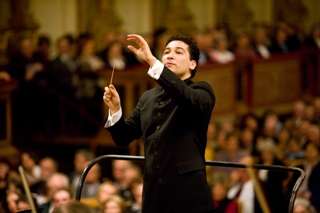|
Back
Let the Music Speak, Please Houston
Jones Hall
05/26/2016 - & May 27, 28, 29, 2016
Witold Lutoslawski: Concerto for Orchestra
Antonín Dvorák: Symphony No. 9 in E Minor, Op. 95, “From the New World”
Houston Symphony, Andrés Orozco-Estrada (conductor) 
A. Orozco-Estrada (© Werner Kmetitsch)
Does Andrés Orozco-Estrada trust his Houston audience? It seems less and less like he does, and this is not going to serve him well in cultivating and maintaining an audience in Houston.
Lasting more than 20 minutes, Orozco-Estrada’s muddled preview-cum-apologia preceding Lutoslawski’s Concerto for Orchestra was confusing and frustrating. For those of us who know and love the piece, it offered no valuable information. Why was it paired with the Dvorák? Why is the piece special to Orozco-Estrada? For those unfamiliar with it, the lengthy lecture offered little comfort or clarification. Cobbled together excerpts from Brahms, Bartók, Purcell, and Bach, presented in haphazard order, seemed impersonal. Once the music started, the feeling was exacerbated by Dick and Jane-style slides accompanying the performance (“Look at the Violins!” “Now the Woodwinds!”). No worry, as the maestro himself explained, it wasn’t a big deal if we didn’t like the piece—we all just came for the Dvorák, right?
Technically, the Lutoslawski is in the Houston Symphony’s wheelhouse. Rich string tone, forthright brass, and sinewy woodwind and horn solos were all well-placed and well-defined. Orozco-Estrada’s interpretation, on the other hand, was middle of the road. The “Intrada” was taken at an energetic clip, but peaks were uniform instead of individually tiered, and the coda lacked a clear shape. A slower-than-usual tempo for the “Capriccioso notturno” opening of the second movement exposed lack of alignment in what should be magical, precise gossamer from the strings. The finale’s huge structure came across as overly episodic, a problem again amplified by the slides that naggingly reminded us of each structural division, as if Lutoslawski failed at his job in composing a comprehensible work.
After intermission, the HSO unveiled The Cosmos, the third and final installment of its HD Odyssey series, which pairs well-known, colorful works with imagery from nearby NASA. Duncan Copp, producer of the video content, touted newly-incorporated software that allows live timeline editing of the film, letting the images follow the conductor’s interpretation, a necessity given the interpretive idiosyncrasies of the evening’s performance of Dvorák’s ubiquitous New World Symphony.
A look at the score shows the composer providing no indication of tempo modification through the first movement’s exposition. This, of course, doesn’t mean the conductor is expected to be a metronomic automaton. Conductors as score-devoted as Szell and Toscanini take time here and there, but all within the context of Dvorák’s Allegro molto marking. Orozco-Estrada’s pushing and pulling, however, was extreme, and distracted from the musical discourse. This was most apparent in the closing theme, where all rhythmic momentum evaporated as the tempo literally slowed to a crawl, replete with Willi Boskovsky-esque rubato. The conceit quickly became clear—louder meant faster, softer meant slower—and so it went for the entire piece.
As in the Lutoslawski, the playing of the orchestra was impressive throughout. Adam Dinitz’s cor anglais in the Largo was played with gorgeous tone and phrasing, echoed by the strings’ shadowy response. The dark mahogany of the low brass that opened the Largo contrasted wonderfully with spine-tingling decibels in the finale, where principal clarinetist Mark Nuccio’s elegant second subject was a highlight. Indeed, impressive moments abounded, but this made one wish even more strongly that they were allowed to exist in a more convincing conception of this warhorse. A recording will be released on Pentatone, continuing a late Dvorák cycle that has been received with mixed reviews.
As for the accompanying imagery, much of it was stunning, and there were several moments where sight and sound truly seemed to become one, but it was also easy to become distracted. The HD Odyssey project has been an interesting one, undoubtedly meant to fill Jones Hall and attract new subscribers. The meager attendance at Jones Hall for the premiere of the finale, however, made one wonder if the benefits will outweigh the costs.
Marcus Karl Maroney
|